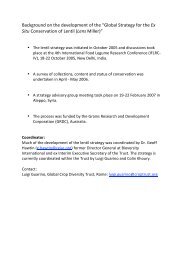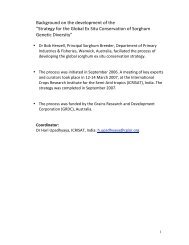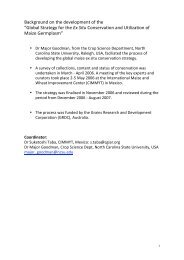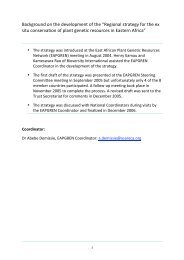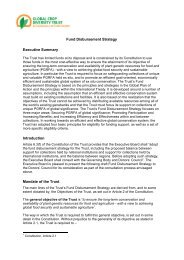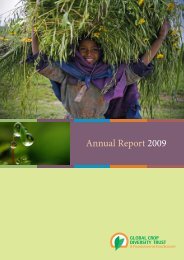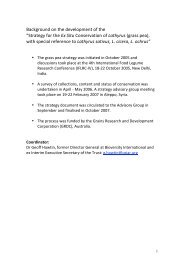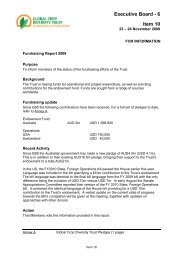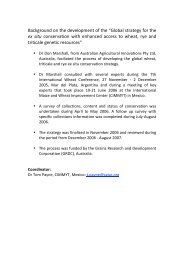Global Strategy for the Ex Situ Conservation of Potato - Global Crop ...
Global Strategy for the Ex Situ Conservation of Potato - Global Crop ...
Global Strategy for the Ex Situ Conservation of Potato - Global Crop ...
You also want an ePaper? Increase the reach of your titles
YUMPU automatically turns print PDFs into web optimized ePapers that Google loves.
1. Genebanks in Europe and North America, with <strong>the</strong> exception <strong>of</strong> <strong>the</strong> VIR genebank,<br />
function ra<strong>the</strong>r well and, relatively speaking, have no major constraints. The mission<br />
report on <strong>the</strong> VIR potato collection revealed that this genebank has problems with<br />
optimal regeneration and storage <strong>of</strong> <strong>the</strong> cultivars collection.<br />
2. The collections in Japan, India and China do not face many constraints, although <strong>the</strong><br />
Indian genebank states to have insufficient trained staff <strong>for</strong> cryopreservation. Curators <strong>of</strong><br />
<strong>the</strong>se genebanks did not participate in <strong>the</strong> Lima workshop.<br />
3. CIP has excellent facilities and, thanks to additional funding, it has lately upgraded its<br />
facilities and conservation activities substantially, and has in particular increased <strong>the</strong><br />
regeneration <strong>of</strong> wild species. The collection <strong>of</strong> CIP contains a large proportion <strong>of</strong> <strong>the</strong><br />
diversity <strong>of</strong> potato, and <strong>the</strong> collection is excellently managed.<br />
4. The collections <strong>of</strong> <strong>the</strong> o<strong>the</strong>r six genebanks in Latin America suffer from a number <strong>of</strong><br />
constraints and should be given high priority <strong>for</strong> receiving funding by <strong>the</strong> Trust. The most<br />
important constraints have been summarized above in Table 2.<br />
5. Insufficient in<strong>for</strong>mation is available on <strong>the</strong> genebank <strong>of</strong> Mexico. It should be noted that<br />
several wild species with genes <strong>for</strong> late blight resistance are found in Mexico. A<br />
representative <strong>of</strong> this country, not being <strong>the</strong> potato curator stated that <strong>the</strong> situation was<br />
very unclear. The questionnaire sent to Mexico has not been returned.<br />
6. In addition to <strong>the</strong> impact <strong>of</strong> a possible support by <strong>the</strong> Trust, o<strong>the</strong>r national and<br />
institutional factors that determine <strong>the</strong> probability <strong>of</strong> sustained proper management <strong>of</strong> <strong>the</strong><br />
collections under <strong>the</strong> given circumstances need to be taken into account. However, it<br />
should be recognized that hard data <strong>for</strong> such considerations are lacking.<br />
In <strong>the</strong> light <strong>of</strong> <strong>the</strong>se conclusions, <strong>the</strong> considerations mentioned under 7.1 and <strong>the</strong> constraints<br />
presented in 7.2 (Table 2), <strong>the</strong> judgement <strong>of</strong> <strong>the</strong> consultant regarding <strong>the</strong> collections <strong>of</strong><br />
highest priority <strong>for</strong> funding under individual agreements are listed in Table 3.<br />
The criteria used to prioritize <strong>the</strong>se collections <strong>for</strong> support are:<br />
! risks <strong>of</strong> losing unique potato germplasm;<br />
! lack <strong>of</strong> adequate facilities <strong>for</strong> conservation;<br />
! (imminent) lack <strong>of</strong> sufficiently trained staff;<br />
! lack <strong>of</strong> proper safety duplication.<br />
Clearly, <strong>the</strong> institutional support <strong>for</strong> <strong>the</strong> listed genebanks needs fur<strong>the</strong>r investigation, be<strong>for</strong>e<br />
Trust funding should be allocated.<br />
Table 3. Collections <strong>of</strong> highest priority <strong>for</strong> capacity building and upgrading<br />
Collections (Country) Total number <strong>of</strong><br />
accessions<br />
Number <strong>of</strong><br />
native cultivars<br />
Number <strong>of</strong><br />
wild species<br />
UACH (Chile) 2,097 331 183<br />
INIAP (Ecuador) 511 222 275<br />
INIA (Peru) 630 310 0<br />
PROINPA (Bolivia) 2,207 1,400 500<br />
VIR (Russia) 8,800 3,400 3,100<br />
CORPOCIA (Columbia) 1,159 915 108<br />
INTA (Argentina) 2,011 551 1,460<br />
Genebanks are listed in this table in declining order <strong>of</strong> urgency <strong>of</strong> <strong>the</strong>ir needs<br />
In <strong>of</strong>fering assistance to <strong>the</strong> genebanks listed in Table 3, it is suggested that <strong>the</strong> highest<br />
priority should be given to <strong>the</strong> conservation <strong>of</strong> clonally propagated native cultivars from <strong>the</strong><br />
centre <strong>of</strong> diversity. However, duplication between <strong>the</strong>se collections should be identified first,<br />
and adequate database in<strong>for</strong>mation may assist in this activity. The conservation <strong>of</strong><br />
accessions <strong>of</strong> wild relatives in <strong>the</strong>se genebanks should not yet receive high priority, as o<strong>the</strong>r<br />
genebanks in <strong>the</strong> world, notably at CIP and in Europe and North America, conserve this type<br />
24




